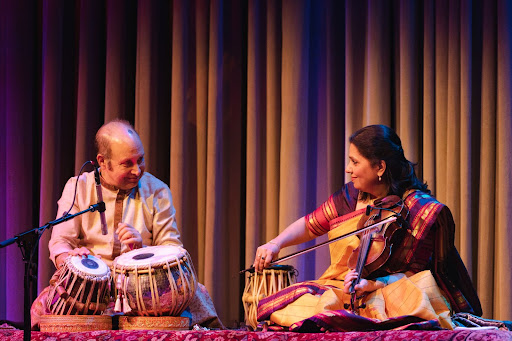After the evening’s final applause, silence fell onto the crowd at Bing Studio. As the performers walked off stage, the woman next to me broke the tension: “Was that it? It went too fast.”
In many ways, I find this remark summative of the performance, which was the first with Stanford Live for Hindustani classical violinist Kala Ramnath. On Thursday, March 23, Ramnath — accompanied by tabla player Abhijit Banerjee — brought an hour of rich Hindustani tradition to a nearly packed Bing Studio. Just as the woman said, it was all over too quickly.
Frankly, my experience with Indian violin music is quite limited; I grew up firmly within the Western canon. Yet it is apparent that Ramnath is a musical savant with such precision, control and exhilarating momentum that it’s hard for most to keep up.
In Western classical music, we tend to celebrate our virtuosi for their command of projection, expression and technical impossibilities. Just in the world of violin soloists, we can identify three musicians — Hilary Hahn, Itzhak Perlman and Ziyu He — who are famous for each of these three traits, respectively. But so many aspects of musicianship are lost with this definition, not least of which are the fields of coloration and improvisation. These two are fundamentals that, to varying degrees, hold an even greater significance than the others outside the Western tradition.
Ramnath displayed them both with unmitigated talent. I first observed her acute microtonal control (i.e. the adjusting of her tuning by fractions of a semitone). It is hard to overstate the expressive power of this technique, which links strongly to Hindustani vocal music and its inflective ornamentation.
Along with a bow control that allowed her to pull nearly any tone out of the instrument, these microtonal adjustments gave Ramnath’s playing a shocking resonance on an auditory and emotional level. Many have dubbed her sound the “Singing Violin,” but I feel that title doesn’t fully capture the brilliance and range of Ramnath’s coloration.
One way that her style differs from Western classical is in the instrument’s tuning: Ramnath used DADA tuning, as opposed to the typical GDAE for violins or CGDA for violas. The result was an exceedingly warm sound that I can best compare to hot apple cider on a winter evening. Granted, that richness also owed to her wonderful technique.
Ramnath’s playing is nothing short of dizzying. Though I cannot pinpoint what proportion of the performance was improvised, I can say that Ramnath writes a melodic variation like no one else. Hindustani music is based on ragas, scale groups that act somewhat like Western modes but also convey emotional and spiritual meanings. (Thursday’s program included Dhanashree, which sounds like Ionian, and Madhmad Sarang, which sounds like Dorian.)
Ramnath danced across these ragas like lightning through a thunderous sky, embellishing with trills and mordants without a misstep. All the while, she took care to place special emphasis on the defining notes of each raga, and even more so on the themes that defined each piece.
My favorite parts of the evening were the small interactions Ramnath had with Banerjee. As the tabla player, Banerjee is tasked with keeping rhythm, setting the tone and tempo and balancing the violin in energy. Though both musicians seemed capable of synergizing using just their ears, the two often shared eye contact and a little smile. These moments were mostly used to sync up at the end of melodic phrases — where the two- or three-note “theme” of the piece recurs — but also showed that the two were having a good time.
Banerjee often fell behind Ramnath’s blinding speed (at one point, they completely stopped to reset), but the two maintained composure. Fallibility is relatable, and it brought the performers closer to the audience.
Still, the performance felt more like an observation of music-making than an immersive experience. Many of us in Arts & Life praise Bing Studio for its intimacy, but Thursday’s affair carried a strange air of disingenuousness. Perhaps it was the staging, or the relative silence of the audience throughout the night, or the way Ramnath and Banerjee took time to set up their instruments, or even the bar.
Something about the performance made it feel more like a museum exhibit than a shared experience. Though I’m sure it would not be a solution, I wonder how taking these performances to the main hall would change the audience experience.
Regardless, I was enchanted by Ramnath’s musicality and humility. Her playing is “too fast,” but in the most spellbinding ways. I believe the violin is one of mankind’s greatest inventions, and Ramnath is living proof of its expressivity and versatility.
Editor’s Note: This article is a review and includes subjective thoughts, opinions and critiques.
